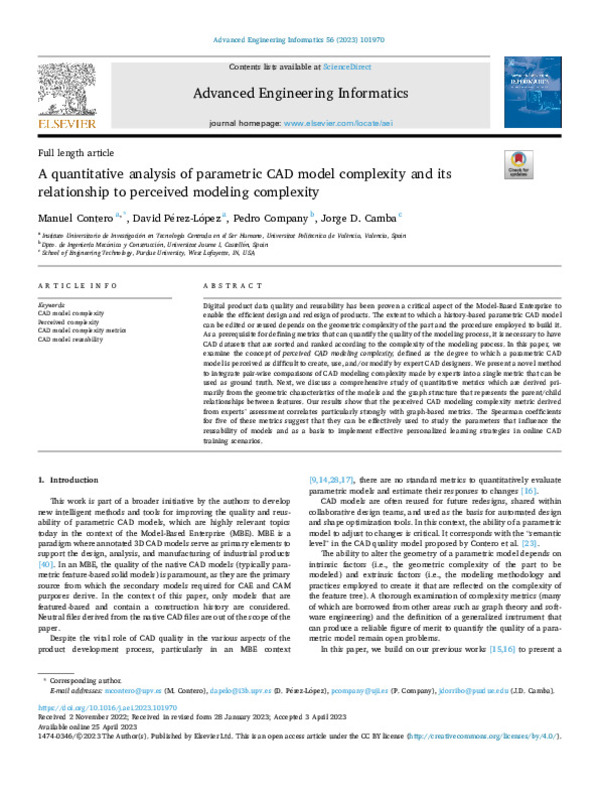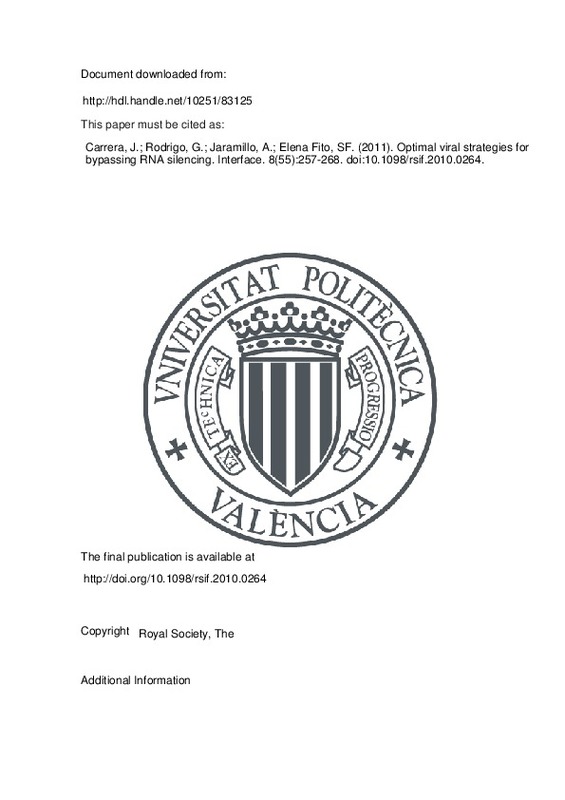JavaScript is disabled for your browser. Some features of this site may not work without it.
Buscar en RiuNet
Listar
Mi cuenta
Estadísticas
Ayuda RiuNet
Admin. UPV
A quantitative analysis of parametric CAD model complexity and its relationship to perceived modeling complexity
Mostrar el registro sencillo del ítem
Ficheros en el ítem
| dc.contributor.author | Contero, M.
|
es_ES |
| dc.contributor.author | Pérez Lopez, D.
|
es_ES |
| dc.contributor.author | Company, P.
|
es_ES |
| dc.contributor.author | Camba, J.D.
|
es_ES |
| dc.date.accessioned | 2024-04-26T18:02:50Z | |
| dc.date.available | 2024-04-26T18:02:50Z | |
| dc.date.issued | 2023-04 | es_ES |
| dc.identifier.issn | 1474-0346 | es_ES |
| dc.identifier.uri | http://hdl.handle.net/10251/203801 | |
| dc.description.abstract | [EN] Digital product data quality and reusability has been proven a critical aspect of the Model-Based Enterprise to enable the efficient design and redesign of products. The extent to which a history-based parametric CAD model can be edited or reused depends on the geometric complexity of the part and the procedure employed to build it. As a prerequisite for defining metrics that can quantify the quality of the modeling process, it is necessary to have CAD datasets that are sorted and ranked according to the complexity of the modeling process. In this paper, we examine the concept of perceived CAD modeling complexity, defined as the degree to which a parametric CAD model is perceived as difficult to create, use, and/or modify by expert CAD designers. We present a novel method to integrate pair-wise comparisons of CAD modeling complexity made by experts into a single metric that can be used as ground truth. Next, we discuss a comprehensive study of quantitative metrics which are derived pri-marily from the geometric characteristics of the models and the graph structure that represents the parent/child relationships between features. Our results show that the perceived CAD modeling complexity metric derived from experts' assessment correlates particularly strongly with graph-based metrics. The Spearman coefficients for five of these metrics suggest that they can be effectively used to study the parameters that influence the reusability of models and as a basis to implement effective personalized learning strategies in online CAD training scenarios. | es_ES |
| dc.description.sponsorship | This work was supported by a grant provided by Vice-rectorate for Research from Universitat Politecnica de Valencia (PAID-11-21) and the Spanish Ministry of Universities in the framework of the State Programme for the Promotion of Talent and its Employability in R & D & I, State Mobility Sub-programme of the State Plan for Scientific and Technical Research and Innovation 2017-2020 (Grant PRX21-00387). | es_ES |
| dc.language | Inglés | es_ES |
| dc.publisher | Elsevier | es_ES |
| dc.relation.ispartof | Advanced Engineering Informatics | es_ES |
| dc.rights | Reconocimiento (by) | es_ES |
| dc.subject | CAD model complexity | es_ES |
| dc.subject | Perceived complexity | es_ES |
| dc.subject | CAD model complexity metrics | es_ES |
| dc.subject | CAD model reusability | es_ES |
| dc.subject.classification | DIBUJO | es_ES |
| dc.subject.classification | EXPRESION GRAFICA EN LA INGENIERIA | es_ES |
| dc.title | A quantitative analysis of parametric CAD model complexity and its relationship to perceived modeling complexity | es_ES |
| dc.type | Artículo | es_ES |
| dc.identifier.doi | 10.1016/j.aei.2023.101970 | es_ES |
| dc.relation.projectID | info:eu-repo/grantAgreement/UPV-VIN//AYUDA PAID-11-21//HERRAMIENTAS INTELIGENTES PARA SOPORTAR LA CREACION Y REUTILIZACION DE MODELOS CAD PARAMETRICOS Y PROCEDURALES DE ALTA CALIDAD/ | es_ES |
| dc.relation.projectID | info:eu-repo/grantAgreement/UPV//PAID-11-21/ | es_ES |
| dc.relation.projectID | info:eu-repo/grantAgreement/MIU//PRX21-00387/ | es_ES |
| dc.rights.accessRights | Abierto | es_ES |
| dc.contributor.affiliation | Universitat Politècnica de València. Escuela Técnica Superior de Ingenieros Industriales - Escola Tècnica Superior d'Enginyers Industrials | es_ES |
| dc.contributor.affiliation | Universitat Politècnica de València. Facultad de Bellas Artes - Facultat de Belles Arts | es_ES |
| dc.description.bibliographicCitation | Contero, M.; Pérez Lopez, D.; Company, P.; Camba, J. (2023). A quantitative analysis of parametric CAD model complexity and its relationship to perceived modeling complexity. Advanced Engineering Informatics. 56. https://doi.org/10.1016/j.aei.2023.101970 | es_ES |
| dc.description.accrualMethod | S | es_ES |
| dc.relation.publisherversion | https://doi.org/10.1016/j.aei.2023.101970 | es_ES |
| dc.type.version | info:eu-repo/semantics/publishedVersion | es_ES |
| dc.description.volume | 56 | es_ES |
| dc.relation.pasarela | S\510620 | es_ES |
| dc.contributor.funder | Ministerio de Universidades | es_ES |
| dc.contributor.funder | UNIVERSIDAD POLITECNICA DE VALENCIA | es_ES |
| dc.contributor.funder | Universitat Politècnica de València | es_ES |










